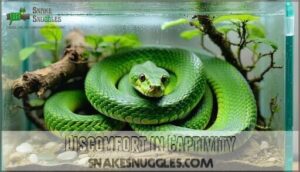This site is supported by our readers. We may earn a commission, at no cost to you, if you purchase through links.
 Snakes make terrible pets because they’re wild animals forced into unnatural captivity, where 75% die within their first year.
Snakes make terrible pets because they’re wild animals forced into unnatural captivity, where 75% die within their first year.
You’ll struggle with their complex needs – specific temperatures, humidity, and specialized diets that most owners can’t provide properly.
They don’t bond with humans, carry diseases like salmonella, and often escape their enclosures.
Unlike domesticated animals, snakes haven’t evolved alongside humans and remain stressed, unhappy creatures in glass boxes.
Their suffering isn’t worth your curiosity. The shocking reality goes deeper than most people realize.
Table Of Contents
- Key Takeaways
- The Cruelty of The Pet Trade
- Inadequate Captive Environments
- Misleading Information About Snakes as Pets
- Challenges in Meeting Snakes’ Needs
- Ethical and Health Concerns for Snakes and Owners
- Snakes’ Well-being in Captivity
- Snakes as Non-Domesticated Animals
- Discomfort in Captivity
- Health Risks Associated With Snakes
- Frequently Asked Questions (FAQs)
- Are snakes the most hated animal?
- What are the bad things about pet snakes?
- Would a snake make a good pet?
- Are snakes unhappy as pets?
- Are snake bites from pet species dangerous?
- What legal restrictions exist for snake ownership?
- How much do snake veterinary bills cost?
- Can snakes recognize or bond with owners?
- What happens to unwanted pet snakes?
- Conclusion
Key Takeaways
- You’ll face serious health risks from salmonella bacteria that 75% of snakes carry, which can cause severe illness in children and immunocompromised individuals
- You can’t provide the complex care snakes need – they require precise temperature gradients, specific humidity levels, and specialized diets that most owners fail to maintain properly
- You won’t get any emotional connection since snakes can’t bond with humans, recognize you, or show affection like domesticated pets do
- You’re supporting a cruel industry built on wildlife exploitation where snakes are ripped from natural habitats and suffer in inadequate captive conditions that cause 30-75% to die within their first year
The Cruelty of The Pet Trade
Before diving into snake ownership, consider this: behind every "pet" snake lies a chain of Wildlife Exploitation that’d make your skin crawl.
The exotic pet trade operates like a cruel machine, where Animal Suffering starts long before these creatures reach store shelves. Most snakes endure horrific conditions in Pet Mills, cramped into filthy enclosures with zero regard for their wellbeing.
Behind every "pet" snake lies a web of Wildlife Exploitation that strips these creatures from their natural homes.
Exotic Trafficking rips countless snakes from their natural habitats, subjecting them to grueling transport conditions where many die before reaching buyers. This Cruel Trade prioritizes profit over animal welfare, with investigations revealing workers freezing snakes to death or leaving them to suffer in neglect.
When you support snake ownership ethics that ignore these realities, you’re inadvertently funding animal exploitation. The reptile welfare crisis in this industry runs deeper than most realize, making exotic pet risks extend far beyond individual ownership decisions.
Inadequate Captive Environments
Think of a snake’s glass terrarium like a luxury prison – it might look nice from the outside, but it’s still a cage that strips away everything that makes a snake truly alive.
Your pet snake can’t burrow into cool earth, bask under real sunlight, swim through natural waters, or climb the trees their wild cousins navigate with ease, which is a key aspect of their life in the wild.
Lack of Natural Behaviors
Imagine watching a snake desperately pace the same two-foot glass prison day after day. That’s captive stress in action.
In natural habitats, snakes travel miles, hunt complex prey, and bask under real sunlight. Your terrarium can’t replicate this behavioral richness.
Environmental deprivation hits hard – no dirt to burrow in, no trees to climb, no seasonal changes. These behavioral limitations create chronic stress that manifests as repetitive movements, appetite loss, and immune suppression.
Snake captivity issues stem from this fundamental mismatch between their wild instincts and your living room’s restricted movement opportunities. Properly designed snake enclosure systems can help mitigate some of these issues.
Restricted Activities
Beyond simple confinement, you’re denying your snake fundamental activities that define their existence.
Picture a marathon runner forced into a wheelchair – that’s captive stress in action.
Commercial terrariums severely limit movement, preventing natural behaviors like extended swimming, climbing, and territorial exploration.
This environmental deprivation creates restricted exercise patterns that compromise physical health.
Snake handling dangers increase when frustrated animals attempt escape from inadequate spaces.
These snake care issues highlight how snake behavior issues develop from restricted activities, making snake ownership risks far greater than most realize, due to the impact of captive stress and environmental deprivation on the snake’s overall well-being, leading to increased handling dangers.
Misleading Information About Snakes as Pets
You’ve probably heard snakes are "easy, low-maintenance pets" – but this couldn’t be further from the truth.
The pet industry routinely downplays the complex care requirements and alarming mortality rates that make snakes unsuitable companions for most people.
High-Maintenance Needs
You’ll quickly discover that snakes aren’t the low-maintenance pets they’re often marketed as.
You’ll discover that promises of "easy" snake care quickly crumble under reality’s harsh demands.
These high-maintenance pets demand specialized care that many owners can’t provide, leading to serious snake care issues and escalating maintenance costs.
Consider these demanding requirements:
- Habitat Requirements: Precise temperature gradients (75°F-95°F), specific humidity levels, and UVB lighting
- Dietary Needs: Species-specific feeding schedules varying from weekly to monthly intervals
- Environmental Demands: Proper substrate, water quality monitoring, and bacterial contamination prevention
- Handling Risks: Specialized knowledge needed to prevent stress-induced illness and defensive aggression
Research shows 62% of novice owners fail to maintain proper conditions, while 72% underestimate the time commitment.
When you factor in snake health risks and ongoing expenses, these aren’t beginner-friendly companions—they’re complex animals requiring veterinary expertise that’s available in only 15% of practices.
Proper snake care products are essential to mitigate these issues and guarantee the well-being of the snake.
Shorter Lifespan in Captivity
When you think you’re giving your snake the best life possible, captivity stress actually cuts their lifespan by 30-50% compared to wild counterparts.
Ball pythons that should live 20-30 years in nature typically survive only 10-15 years as high-maintenance pets, while corn snakes face even shorter lifespans due to poor care in captive environments.
- Wild ball pythons basking freely under African sun for decades
- Captive snakes confined to glass tanks, aging prematurely from chronic stress
Snake ownership inevitably leads to shortened lifespan in captivity, with mortality rates skyrocketing from environmental limitations and animal suffering.
Proper corn snake care is essential to mitigate the effects of captivity on their lifespan, ensuring a better life for your pet snake.
High Mortality Rate
Research shows alarming snake mortality statistics that contradict pet industry marketing.
Studies reveal 30-75% annual death rates for captive snakes, with only 10-15% surviving beyond two years.
These shocking reptile deaths stem from:
- Captive stress weakening immune systems before inevitable snake suffering
- Wild capture trauma creating mortality factors that persist long-term
- Highmaintenance pets requiring expertise most owners lack.
These snake health issues make snake ownership risks undeniably high.
Challenges in Meeting Snakes’ Needs
You’d think caring for a snake would be straightforward, but these creatures have incredibly specific needs that most people can’t meet.
From precise temperature gradients to specialized lighting and humidity levels, getting it wrong often means your snake won’t survive its first year.
Specific Care Requirements
You’ll quickly discover that snake care demands precision that rivals operating room standards.
Temperature regulation requires basking spots at 85-90°F with cooler zones around 75°F, while humidity control must match each species’ exact needs to prevent respiratory infections or fatal shedding problems.
| Care Aspect | Requirements | Common Failures |
|---|---|---|
| Temperature Regulation | Species-specific gradients, specialized heating | Improper zones cause digestive disorders |
| Humidity Control | Precise levels, constant monitoring | Wrong humidity leads to skin infections |
| Dietary Needs | Species-specific prey, exact feeding schedules | Malnutrition, life-threatening food refusal |
| Lighting Requirements | Full-spectrum UV, proper photoperiods | Poor lighting affects overall health |
| Habitat Design | Secure enclosures, environmental enrichment | Inadequate space causes chronic stress |
These high-maintenance pets require expensive equipment and vigilant monitoring, making proper snake habitat needs nearly impossible for average owners.
Understanding species habitat needs is vital for providing the best care and preventing health issues in captive snakes.
Lack of Suitable Environments
Even when you’ve got the specific care requirements down, there’s another massive hurdle: most snake enclosures are completely inadequate.
Imagine this scenario – you’re trying to house a creature that might roam miles in the wild inside what’s basically a glass shoebox.
Inadequate housing with insufficient space creates immediate captivity stress. Poor ventilation, inappropriate temperature zones, and limited lighting systems compound these environmental stressors.
Your average pet store snake enclosures can’t replicate the complex snake habitat needs these animals require. Without proper snake environmental control, you’re setting up both yourself and your snake for failure from day one.
Creating a snake friendly environment is essential for their well-being, but often neglected in domestic settings. This is a critical aspect of snake care, as it directly impacts the snake’s health and happiness. Proper care requires attention to detail and a commitment to providing a suitable environment, which can be a significant challenge for many snake owners, leading to potential disaster if not addressed properly.
Ethical and Health Concerns for Snakes and Owners
When you’re considering a snake as a pet, you’re not just making a choice that affects you—you’re potentially supporting an industry built on cruelty.
The pet trade rips these animals from their natural habitats or breeds them in horrific conditions, while snakes carry dangerous bacteria like salmonella that can seriously harm humans, especially kids and pregnant women.
Cruelty in The Pet Trade
When you buy that "adorable" ball python, you’re funding a system built on Wildlife Exploitation and Animal Abuse.
Pet Mills cram snakes into filthy, overcrowded conditions where workers freeze them alive or abandon them to die. The Illegal Trade strips wild populations while the pet trade ignores Captive Suffering completely.
Your purchase directly supports animal suffering through speciesism, treating snakes as disposable commodities rather than sentient beings deserving animal rights protection. The pet trade also disregards important snake welfare considerations that prioritize the well-being of these animals.
Health Risks to Humans
Beyond the ethical concerns of snake ownership lies a more immediate threat—your health.
You’re playing Russian roulette with dangerous pathogens every time you handle these reptiles.
Snakes harbor serious health risks that can devastate families:
- Salmonella infections causing severe diarrhea, fever, and potential death
- Zoonotic diseases like botulism spreading through contaminated surfaces
- Bacterial transmission via snake bites, saliva, or fecal matter
- Disease outbreaks affecting children under 5 and immunocompromised individuals
- Human infections from parasites, worms, and harmful bacteria
Even healthy-looking snakes carry Salmonella in their digestive systems.
You can’t see these microscopic threats, making every interaction a gamble with your family’s wellbeing.
Snakes’ Well-being in Captivity
You might think you’re providing a loving home, but your snake can’t tell you when something’s wrong—and by the time you notice, it’s often too late.
Most snake owners unknowingly subject their pets to a slow decline because these animals hide illness and stress so well that even experienced keepers miss the warning signs, which can lead to a slow decline.
Overlooked Specialized Care
You’ll quickly discover that snakes as pets demand specialized care that’s both expensive and complex.
Their dietary needs, lighting requirements, temperature control, and humidity levels aren’t optional – they’re life-or-death necessities.
Most pet snake problems stem from owners underestimating these snake care challenges, leading to costly veterinary access needs and overwhelming snake responsibilities, which can be considered costly.
Lack of Understanding About Needs
Understanding your pet snake’s needs isn’t like reading a dog’s wagging tail.
Silent Signals from snakes create massive snake care challenges, leaving owners guessing about Dietary Confusion and Habitat Misconceptions.
This Temperament Ignorance leads to Unmet Needs, making snakes as pets particularly problematic.
Unlike vocal animals, pet snake problems stem from their inability to communicate discomfort or illness clearly.
Challenges in Mimicking Natural Environments
Replicating natural environments for snake care proves nearly impossible in home settings.
Even experienced owners struggle with proper snake habitat requirements, making snake ownership challenging despite best intentions.
To guarantee snake well-being, owners should prioritize high-quality reptile supplies.
Key environmental challenges include:
- Enclosure Size: Most tanks restrict natural movement and stretching behaviors
- Temperature Gradients: Maintaining species-specific thermal zones requires expensive equipment and constant monitoring
- Humidity Control: Precise moisture levels prevent shedding problems but demand specialized systems
- Lighting Requirements: Proper photoperiods and UV spectrum needs often go unmet in standard setups
Diverse Needs of Snakes
Meeting every snake’s diverse needs feels like solving a complex puzzle—and most owners get it wrong.
Each species requires specific thermal gradients, dietary variety, and habitat complexity that’s nearly impossible to replicate at home.
Consider these overwhelming snake care challenges:
- Temperature zones spanning 20+ degrees require expensive equipment
- Dietary variety from live rodents to specialized prey items
- Shedding issues from improper humidity levels cause serious health problems
- Enrichment needs include climbing, burrowing, and swimming opportunities
- Snake behavior varies dramatically between nocturnal and diurnal species, with unique requirements for each.
The challenges of snake care are further complicated by the need to provide a suitable environment, making it a difficult task for owners to ensure their pets receive the proper care, leading to potential health problems.
Snakes as Non-Domesticated Animals
Unlike traditional pets that evolved alongside humans over thousands of years, snakes remain wild animals with zero domestication history.
You can’t expect the loyal companionship of a dog or the affectionate purring of a cat—snakes simply don’t form emotional bonds with their owners and remain largely indifferent to human interaction.
Lack of Historical Symbiotic Relationship
Unlike cats and dogs, snakes haven’t undergone thousands of years of domestication alongside humans.
This evolutionary mismatch makes them unnatural companions with no mutualism between species.
Wild animals by nature, they’re among the worst pet choices due to this domestication absence.
You can’t expect a creature that evolved independently to suddenly become your buddy.
These snake pet drawbacks stem from fundamental biological incompatibility, creating unnecessary snake risks and dangers for unsuitable pets.
Absence of Special Bond
Looking beyond the surface appeal of snake ownership, you’ll discover these reptiles can’t form meaningful bonds with their human caretakers.
Their Emotional Detachment stems from millions of years of evolution as Solitary Nature creatures who’ve never developed social connections.
- Limited Interaction – Snakes don’t seek human companionship or respond to your presence
- Lack of Affection – They can’t reciprocate care or show appreciation like traditional pets
- Unmet Expectations – Most owners expect some level of connection that simply won’t develop
- Snake misconceptions about bonding lead to disappointment in snake ownership experiences
Snakes’ Indifference Towards Owners
You’ll quickly discover that snakes offer zero emotional returns on your investment.
These unresponsive pets show lack affection and provide no companionship – they can’t even recognize you exist!
Your snake won’t greet you after work or comfort you during tough times.
Limited interaction makes snake ownership feel like maintaining an expensive, living decoration rather than enjoying meaningful pet ownership.
| Snake Behavior | What You Get | What You Want |
|---|---|---|
| Feeding response | Mechanical eating | Excited meal time |
| Handling tolerance | Stress endurance | Cuddly interaction |
| Recognition ability | None detected | Personal bond |
| Emotional display | Blank stare | Affectionate response |
| Communication | Silent treatment | Responsive feedback |
This minimal bonding reality makes snakes unsuitable pets for anyone seeking genuine animal companionship.
Discomfort in Captivity
You can’t escape the fact that snakes are miserable in captivity, spending their lives in cramped glass boxes that deny every natural instinct they possess.
What’s worse, stressed snakes become escape artists, and a loose snake in your home creates dangerous situations for both you and your family.
Confinement and Stress
Captivity stress wreaks havoc on snakes in ways you wouldn’t expect. These reptiles aren’t wired for confined living, and their bodies rebel against it.
When you trap a snake in a glass box, you’re basically creating a pressure cooker of anxiety that leads to serious health consequences.
Here’s what captivity stress does to your snake:
- Limited movement causes muscle atrophy and joint problems
- Behavioral changes include repetitive pacing and aggression
- Environmental stressors trigger immune system suppression
This behavioral deprivation doesn’t just make snakes miserable—it kills them. Snake welfare experts report that captivity-induced stress substantially reduces lifespan and accelerates health decline through chronic cortisol elevation.
Escaping and Dangers Posed
Pet snake escapes happen more often than you’d think, creating real public safety concerns.
Your crafty serpent can slip through surprisingly small gaps, turning your home into a dangerous game of hide-and-seek.
Identifying escapes quickly becomes critical when neighbors discover your ball python in their garden or basement.
Prevention methods like secure locks often fail because snakes are natural Houdinis.
Once loose, these animals face environmental impact from temperature changes while potentially threatening local wildlife.
The escape frequency among pet owners reaches alarming levels, making snake dangers a community-wide problem rather than just yours.
Health Risks Associated With Snakes
You don’t just get a pet when you bring home a snake—you get a potential health hazard that could make you seriously sick.
From salmonella infections to parasitic diseases, snakes carry multiple pathogens that can hospitalize humans, especially children and those with weakened immune systems.
Salmonella and Zoonotic Diseases
Despite the domestic facade, snakes harbor serious health threats that’ll make you think twice.
Over 70% of pet snakes carry Salmonella bacteria, causing severe diarrhea and potentially fatal infections. Snake-borne illnesses don’t stop there—you’re also risking Mycobacterium and Pseudomonas infections.
Disease transmission occurs through direct contact or contaminated enclosures, making hygiene importance critical. Vulnerable populations like children under five face heightened risks, with parasitic risks from worms and ticks adding another layer of danger.
These snake diseases make ownership considerations far more complex than most realize, involving potentially fatal infections and parasitic risks.
Potential Future Threats
The unknown dangers lurking in snake ownership extend far beyond today’s documented health risks.
Climate change and global trade are creating perfect storms for emerging diseases that haven’t crossed into human populations yet. Snake Fungal Disease (SFD) appeared seemingly overnight, affecting both captive and wild populations worldwide.
You’re basically playing biological roulette with escaped snakes potentially introducing novel pathogens into ecosystems. These invasive species disrupt delicate food webs while carrying unknown genetic diversity that could spawn new conservation nightmares.
Understanding zoonotic disease transmission is vital for mitigating risks. Current snake regulations can’t keep pace with these evolving threats, making snake safety concerns more unpredictable than ever.
Frequently Asked Questions (FAQs)
Are snakes the most hated animal?
Snakes aren’t universally hated, but they’re among the most feared animals due to evolutionary instincts and cultural associations. You’ll find many people appreciate them for pest control and fascinating behaviors.
What are the bad things about pet snakes?
You’ll face serious health risks from salmonella bacteria that even healthy snakes carry naturally.
Their complex care needs – precise temperature, humidity, lighting, and diet – are expensive and difficult to maintain properly, leading to high mortality rates.
Would a snake make a good pet?
You shouldn’t consider a snake as your ideal pet.
They’re challenging to care for, carry health risks like salmonella, can’t show affection, and have complex needs that most owners struggle to meet properly.
Are snakes unhappy as pets?
Research shows captive snakes experience chronic stress from unnatural environments, restrictive housing, and inability to express natural behaviors.
You’ll find they can’t communicate distress effectively, making their suffering invisible to most owners.
Are snake bites from pet species dangerous?
Most pet snake bites aren’t life-threatening, but they’re definitely not fun.
Non-venomous species like ball pythons can still cause painful puncture wounds that risk infection if you don’t clean them properly afterward.
What legal restrictions exist for snake ownership?
Laws vary wildly by state, but you’ll typically need permits for venomous species, large constrictors, or exotic varieties.
Most states require permits to catch and keep venomous snakes as pets, while some require licenses for snakes longer than 10-12 feet.
How much do snake veterinary bills cost?
Snake vet bills can cost you $40-$80 for routine checkups, but emergency care jumps to $100-$800 or more.
Vet visits cost $40 to $80 for checkups or about $100 to $800+ for emergency care.
That’s pricey considering most snake owners rarely take their pets for preventative visits, which can lead to higher costs for emergency care.
Can snakes recognize or bond with owners?
No, snakes don’t recognize or bond with you.
They lack the brain structures for emotional attachment and social recognition.
Unlike dogs or cats, they’re solitary creatures who tolerate handling at best, viewing you as a warm tree rather than a companion, because they essentially lack the capacity for emotional attachment.
What happens to unwanted pet snakes?
Unwanted reptiles often end up abandoned at shelters, released into inappropriate environments, or surrendered to overwhelmed rescue organizations. You’ll find many facilities struggling with overcrowding and limited resources.
Conclusion
Unlike beloved dogs wagging their tails or purring cats seeking affection, snakes remain perpetually stressed in glass prisons they’ll never escape.
While your childhood goldfish lived happily in its bowl, snakes need complex ecosystems you simply can’t recreate.
The evidence overwhelmingly demonstrates why snakes make for the worst pets – they’re wild animals suffering silently for human entertainment.
Choose a domesticated companion instead; both you and countless reptiles will benefit from this compassionate decision that prioritizes animal welfare over fleeting curiosity.
- https://windsorstar.com/news/python-escapes-from-new-brunswick-pet-store-strangles-two-boys
- https://abcnews.go.com/US/serpent-handling-west-virginia-pastor-dies-snake-bite/story?id=16459455
- https://www.theguardian.com/world/2009/jul/01/python-florida-strangled-child-death
- https://investigations.peta.org/us-global-exotics-exposed/
- https://talis-us.com/blogs/news/snake-in-a-cage-understanding-the-habitat-needs-of-pet-snakes

















